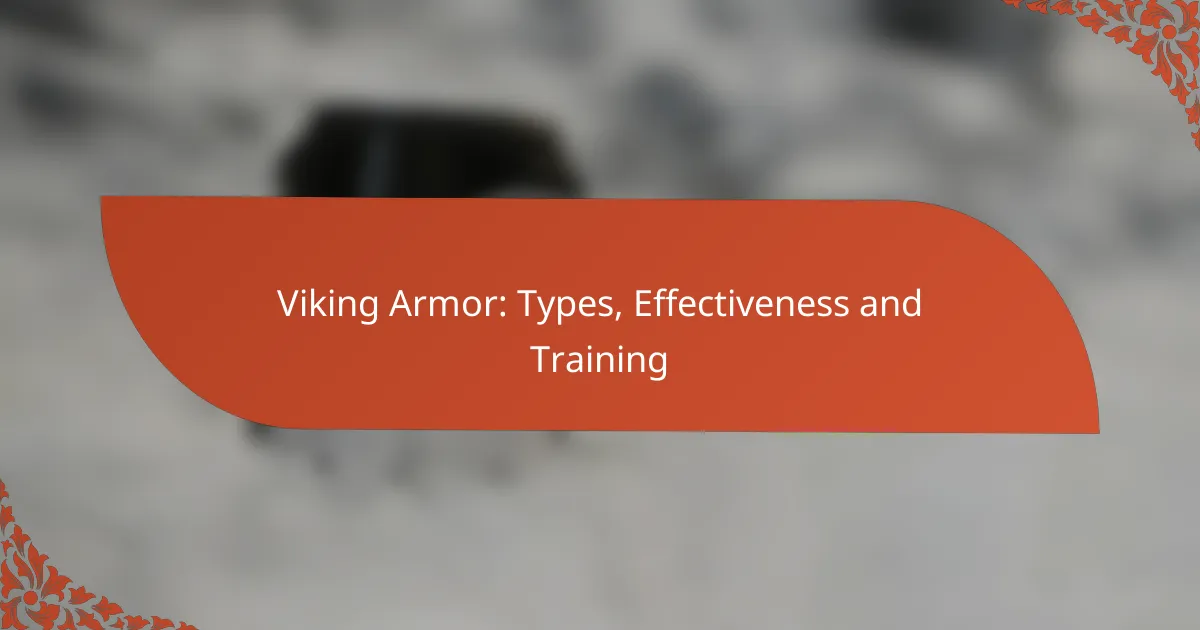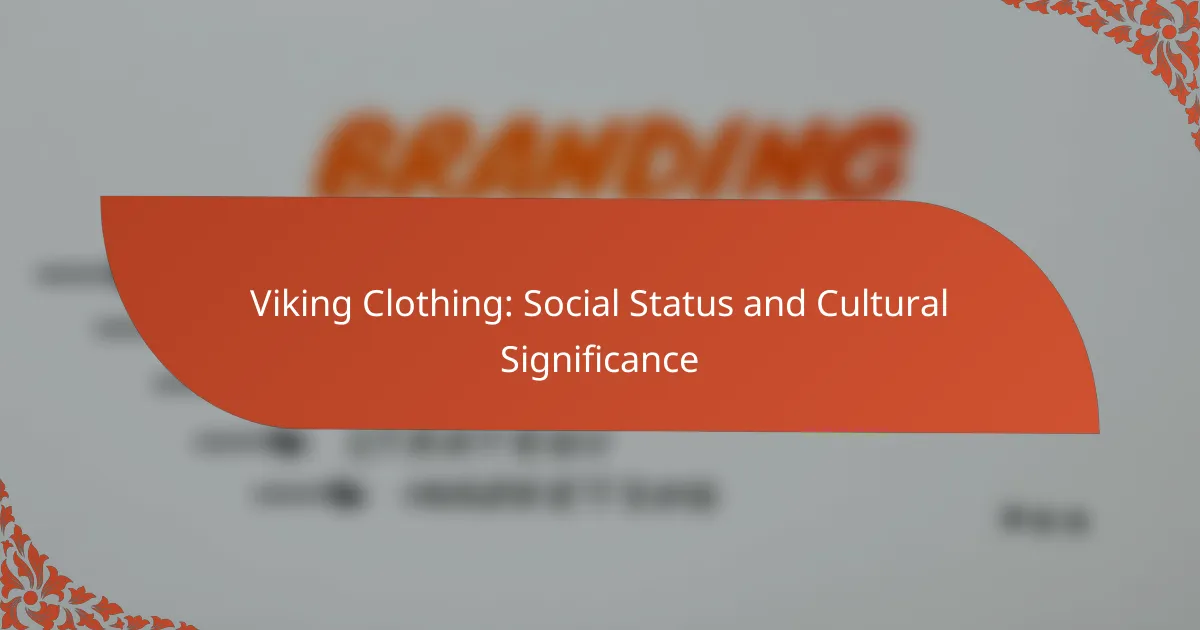Viking armor played a crucial role in their combat strategy, featuring various types such as chainmail, scale armor, and leather, each crafted for protection and mobility. While moderately effective against a range of weapons, the performance of armor depended on its type and the specific battle context. To maximize their effectiveness, Viking warriors engaged in rigorous training to master combat techniques and maintain their equipment.
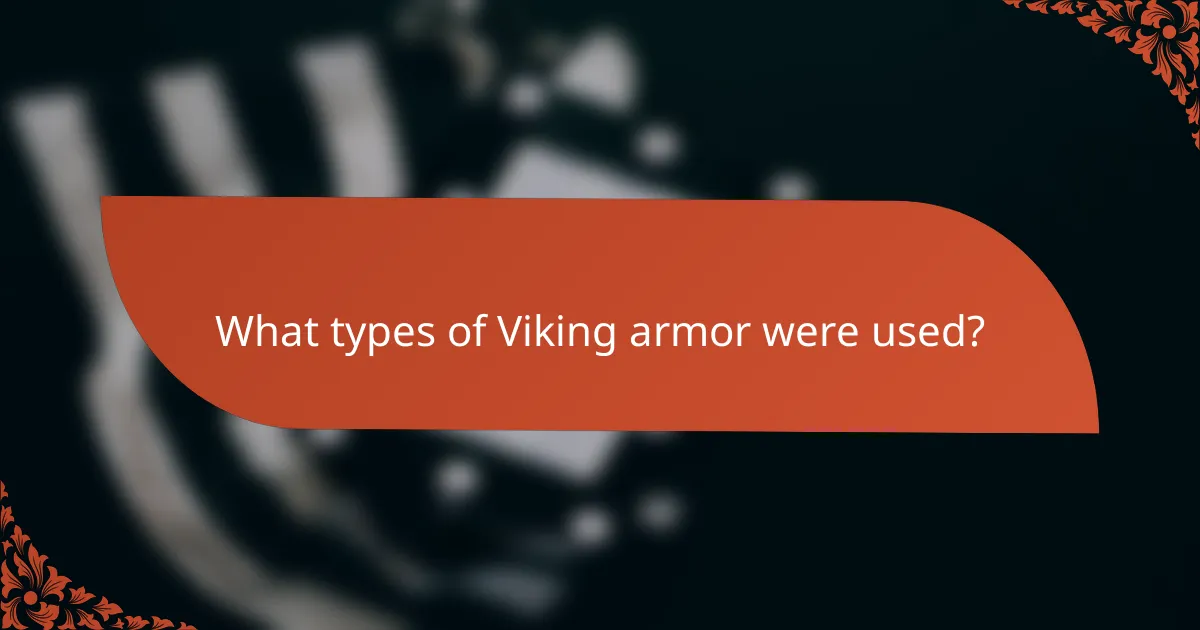
What types of Viking armor were used?
Vikings utilized various types of armor, each designed to provide protection while allowing mobility in battle. The most common types included chainmail, scale armor, leather armor, plate armor, and protective gear like helmets and shields.
Chainmail armor
Chainmail armor, made from interlinked metal rings, was one of the most effective forms of protection used by Vikings. It offered a good balance between flexibility and defense, allowing warriors to move freely while protecting against slashing attacks.
This type of armor typically covered the torso and sometimes extended to the limbs. While it was effective against cutting weapons, it was less effective against blunt force trauma, which could still injure the wearer.
Scale armor
Scale armor consisted of small, overlapping metal plates sewn onto a fabric or leather backing. This design provided solid protection while maintaining some flexibility, making it suitable for combat scenarios.
Scale armor was often heavier than chainmail but offered better defense against piercing attacks. It was less common than chainmail but still used by some Viking warriors, especially those who could afford it.
Leather armor
Leather armor was a more accessible option for many Vikings, crafted from animal hides. While it offered less protection than metal armors, it was lightweight and allowed for greater mobility, making it suitable for skirmishes and quick engagements.
Often reinforced with metal studs or plates, leather armor could absorb some impact and provided decent protection against cuts. However, it was vulnerable to fire and could degrade over time if not properly maintained.
Plate armor
Plate armor, though less common among Vikings, was made from large metal plates that covered vital areas of the body. This type of armor provided superior protection against both cutting and piercing attacks.
Due to its weight and cost, plate armor was typically reserved for wealthier warriors or leaders. It required careful crafting to ensure it fit well and allowed for movement, which was crucial in battle.
Helmets and shields
Helmets and shields were essential components of Viking armor, providing additional protection for the head and body. Viking helmets were often made of iron and featured a rounded shape, sometimes with a nasal guard to protect the face.
Shields were typically round and made from wood, reinforced with metal edges. They were crucial for both defense and offense, allowing warriors to block attacks and create formations during battle.
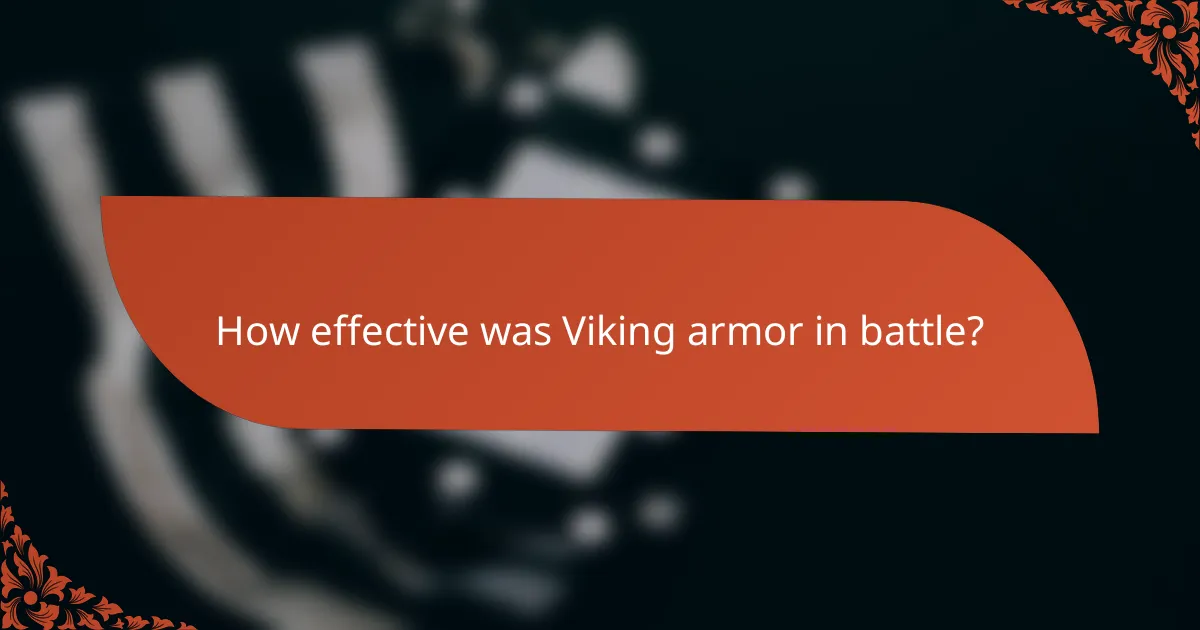
How effective was Viking armor in battle?
Viking armor was moderately effective in battle, providing a balance between protection and mobility. While it could defend against various weapons, its effectiveness varied based on the type of armor and the combat situation.
Protection against weapons
Viking armor primarily consisted of chainmail, leather, and occasionally plate armor, which offered varying levels of protection. Chainmail could effectively absorb slashing attacks from swords and axes, while leather armor provided some defense against lighter blows. However, against piercing weapons like spears, the effectiveness of armor could diminish, especially if not properly fitted.
In addition to personal armor, Vikings used shields, which were crucial for defense. A round shield could deflect blows and projectiles, enhancing overall survivability in combat. The combination of armor and shields created a layered defense that was essential during raids and battles.
Impact on mobility
The design of Viking armor aimed to balance protection with mobility. Chainmail, while protective, could be heavy and restrict movement if not tailored correctly. Warriors needed to maintain agility to maneuver effectively in battle, which sometimes led to the choice of lighter armor options.
Leather armor was lighter and allowed for greater freedom of movement, making it suitable for skirmishes and fast-paced engagements. However, this came at the cost of reduced protection. Vikings often had to make strategic choices about their armor based on the type of combat they anticipated.
Durability in various climates
Viking armor was generally durable but had limitations in different climates. Chainmail could rust if exposed to moisture without proper care, while leather could degrade in wet conditions. Vikings often treated their leather with oils to enhance its water resistance, extending its lifespan.
In colder climates, the layered clothing beneath armor provided insulation, which was beneficial during winter battles. Conversely, in warmer conditions, heavy armor could lead to overheating, impacting performance. Vikings had to adapt their armor choices based on the environment to maintain effectiveness in combat.
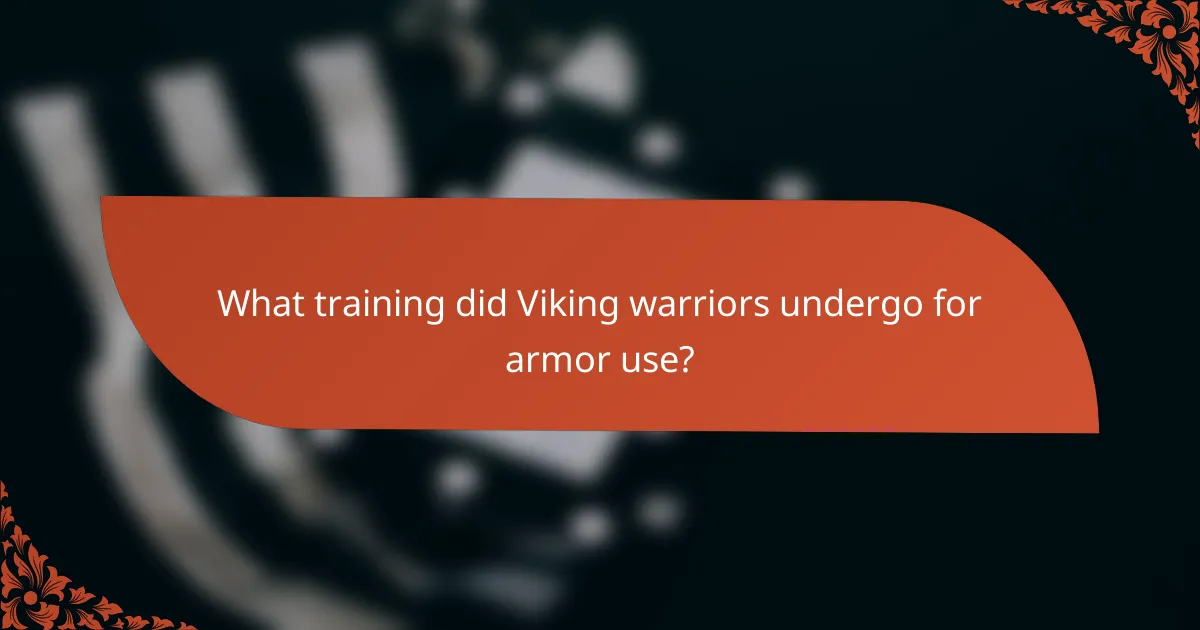
What training did Viking warriors undergo for armor use?
Viking warriors underwent extensive training to effectively use their armor in combat. This training included mastering combat techniques, maintaining their gear, and enhancing their physical fitness to withstand the rigors of battle.
Combat techniques
Viking warriors learned various combat techniques tailored to their armor type, focusing on maximizing protection while maintaining mobility. They practiced using swords, axes, and shields in formations that utilized their armor’s strengths, such as the shield wall tactic.
Training sessions often involved mock battles where warriors would engage in sparring to refine their skills. This hands-on practice helped them understand how to maneuver effectively while wearing heavy armor, allowing them to strike efficiently while minimizing exposure to enemy attacks.
Armor maintenance training
Maintaining armor was crucial for Viking warriors, as damaged gear could compromise their safety. Training included regular inspections and repairs, teaching warriors how to identify wear and tear and perform basic fixes, such as patching leather or reinforcing chainmail.
Warriors were also instructed on proper cleaning techniques to prevent rust and deterioration. This knowledge ensured that their armor remained functional and effective throughout their campaigns, contributing to their overall combat readiness.
Physical conditioning
Physical conditioning was a vital component of a Viking warrior’s training regimen, enabling them to carry heavy armor and endure long battles. Training often included strength-building exercises, such as lifting weights and practicing endurance activities like running or swimming.
Warriors aimed to develop agility and stamina, allowing them to move swiftly on the battlefield. This conditioning not only improved their combat performance but also helped reduce the risk of injury while wearing cumbersome armor during engagements.

How did Viking armor evolve over time?
Viking armor evolved significantly from the early medieval period to the late Viking Age, influenced by various factors including trade, warfare, and cultural exchanges. Initially, Vikings relied on simple leather and chainmail, but over time, they adopted more advanced materials and designs, enhancing their protection in battle.
Influences from other cultures
Viking armor was heavily influenced by interactions with neighboring cultures, particularly the Franks and Byzantines. The introduction of chainmail, for instance, came from contact with these societies, providing better defense against slashing weapons. Additionally, the use of helmets and shields often reflected styles seen in other regions, showcasing a blend of practical design and cultural aesthetics.
Trade routes also played a crucial role in armor evolution. As Vikings traded with various civilizations, they acquired new materials and techniques, which they integrated into their own armor-making practices. This exchange not only improved the quality of their armor but also diversified their combat strategies.
Changes in warfare tactics
The evolution of Viking armor was closely tied to changes in warfare tactics. As battles became more organized, the need for effective protection grew. The shift from raiding to more structured warfare necessitated stronger armor, leading to the development of full-body protection, including breastplates and more sophisticated helmets.
Moreover, the introduction of cavalry and the use of ranged weapons influenced armor design. Vikings began to adapt their gear to counter these new threats, leading to innovations such as reinforced shields and layered armor. This adaptability ensured that Viking warriors remained formidable opponents on the battlefield.

What are the modern interpretations of Viking armor?
Modern interpretations of Viking armor focus on recreating the styles and materials used during the Viking Age, often blending historical accuracy with practical considerations for reenactment and display. These interpretations can vary significantly based on available research, artistic license, and the intended use of the armor.
Reenactment groups
Reenactment groups often strive for historical accuracy while also ensuring the armor is functional for combat simulations. Members typically research various sources, including archaeological finds and historical texts, to create authentic replicas. Common materials used include leather, chainmail, and plate armor, with many groups emphasizing the importance of craftsmanship and period-appropriate techniques.
When participating in reenactments, it is crucial to consider safety alongside authenticity. Many groups establish guidelines for armor that balance historical fidelity with modern safety standards, ensuring that participants can engage in activities without undue risk of injury.
Historical accuracy in films
Films depicting Vikings often take creative liberties with armor design, prioritizing visual impact over strict historical accuracy. While some productions aim for realism, others may incorporate anachronistic elements to enhance storytelling or appeal to contemporary audiences. This can lead to a mix of styles that may not accurately represent the Viking Age.
For viewers interested in the authenticity of Viking armor in films, it is helpful to compare designs with known historical artifacts. Resources such as museums and historical societies can provide insights into what Viking armor truly looked like, allowing for a more informed viewing experience. Understanding these differences can enhance appreciation for both the art of filmmaking and the historical context of the Viking Age.






